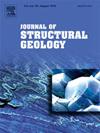Crustal deformation studies in Jammu Himalaya using PSInSAR technique
IF 2.6
2区 地球科学
Q2 GEOSCIENCES, MULTIDISCIPLINARY
引用次数: 0
Abstract
The Jammu Himalaya lies within the deformation zone affected by the 1905 Kangra and 2005 Kashmir earthquakes, where continuous micro-seismic activity has been observed. To understand the patterns of active crustal deformation, Persistent Scatterer Interferometric Synthetic Aperture Radar (PSInSAR) and stream power law equations have been applied to analyse the brittle crust of the Tawi Basin in the northwestern Himalaya. The PSInSAR-based results reveal that from 2017 to 2020, the region experienced active surface deformation with a mean velocity of +16 to −18 mm/yr and a standard deviation of 0–5 mm/yr. These rates align with previous Global Positioning System (GPS) base geodetic arc normal observations (11.2 ± 3.8 mm/yr to 14 ± 2 mm/yr) in the northwest Himalaya. The PSInSAR data show Line of Sight (LoS) displacements ranging from +45 mm to −50 mm, with negative values indicating tectonic subsidence, mass wasting, and erosion, while positive values suggest uplift and sediment deposition. The LoS displacement varied between −50 mm and +40 mm to the south and north of the Mandili-Kishanpur Thrust (MKT), respectively, and these values are consistent with the observed Gradient Length Anomalies (GLA). Crustal deformation is notably high in the hilly and mountainous regions, with knickpoint analysis indicating that uplift associated with crustal shortening contributes to the development of knickpoints. Further, the Tawi river basin in the northwestern Himalayan region is prone to landslides, with high steep slopes in the northern part of the Main Central Thrust (MCT) and Main Boundary Thrust (MBT) zones, being particularly vulnerable, and footwall subsidence to the south potentially linked to active thrust faulting.
利用PSInSAR技术研究查谟-喜马拉雅地区地壳变形
查谟-喜马拉雅位于1905年康格拉地震和2005年克什米尔地震影响的变形带内,在那里观察到连续的微地震活动。为了了解地壳活动变形的模式,应用持续散射干涉合成孔径雷达(PSInSAR)和流幂律方程对喜马拉雅西北部塔威盆地的脆性地壳进行了分析。基于psinsar的观测结果表明,2017 - 2020年,该地区地表活跃形变的平均速度为+16 ~−18 mm/yr,标准差为0 ~ 5 mm/yr。这些速率与以前在喜马拉雅西北部的全球定位系统(GPS)基准大地测量弧正常观测值(11.2±3.8 mm/年至14±2 mm/年)一致。PSInSAR数据显示,视线位移范围为+45 mm至- 50 mm,负值表明构造沉降、物质浪费和侵蚀,而正值表明隆升和沉积物沉积。在Mandili-Kishanpur逆冲(MKT)南侧和北侧,LoS位移分别在−50 mm和+40 mm之间变化,这些值与观测到的梯度长度异常(GLA)一致。在丘陵和山区,地壳变形特别大,裂缝点分析表明,与地壳缩短相关的隆升促进了裂缝点的发育。此外,喜玛拉雅山西北地区的塔威河盆地易发生山体滑坡,其中中央主逆冲带(MCT)和主边界逆冲带(MBT)北部的高陡坡尤其脆弱,南侧下盘沉降可能与活动逆冲断裂有关。
本文章由计算机程序翻译,如有差异,请以英文原文为准。
求助全文
约1分钟内获得全文
求助全文
来源期刊

Journal of Structural Geology
地学-地球科学综合
CiteScore
6.00
自引率
19.40%
发文量
192
审稿时长
15.7 weeks
期刊介绍:
The Journal of Structural Geology publishes process-oriented investigations about structural geology using appropriate combinations of analog and digital field data, seismic reflection data, satellite-derived data, geometric analysis, kinematic analysis, laboratory experiments, computer visualizations, and analogue or numerical modelling on all scales. Contributions are encouraged to draw perspectives from rheology, rock mechanics, geophysics,metamorphism, sedimentology, petroleum geology, economic geology, geodynamics, planetary geology, tectonics and neotectonics to provide a more powerful understanding of deformation processes and systems. Given the visual nature of the discipline, supplementary materials that portray the data and analysis in 3-D or quasi 3-D manners, including the use of videos, and/or graphical abstracts can significantly strengthen the impact of contributions.
 求助内容:
求助内容: 应助结果提醒方式:
应助结果提醒方式:


